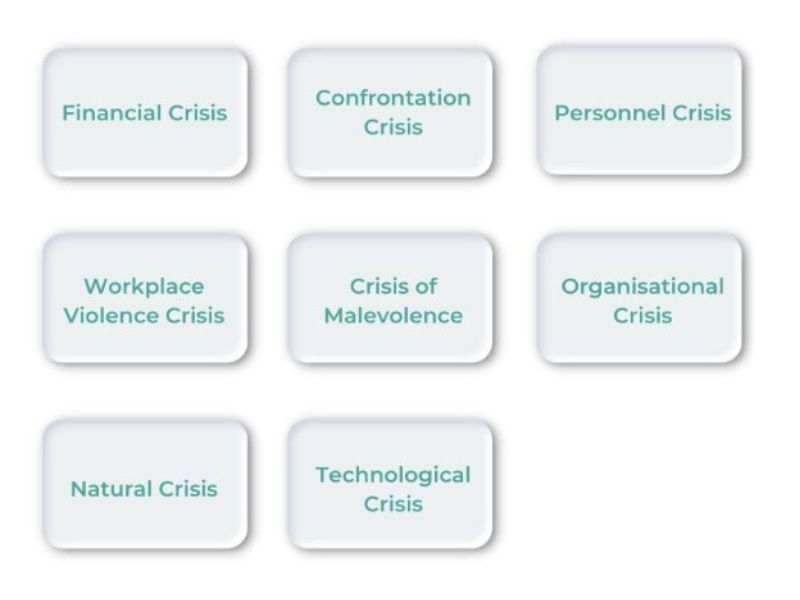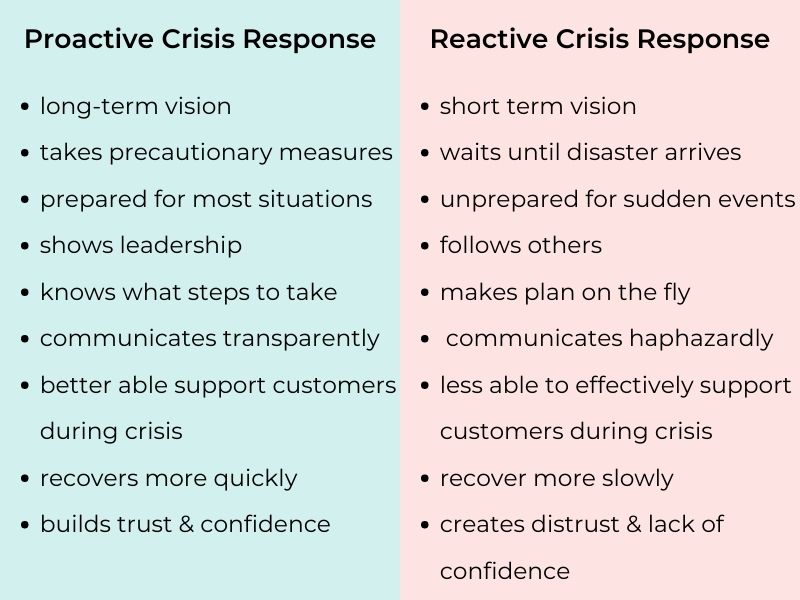Introduction to crisis management and planning
A crisis is an unforeseen event that poses a significant threat to your business operations, reputation, financial strength or stakeholder well-being. It disrupts normal operations and demands swift, strategic actions for mitigation and recovery.
Crises can take various forms, including natural disasters, social media attacks, threats to people or property, financial challenges or organisational upheavals, each with its unique set of implications for your business.
Types of crises

Different types of crises that your business may face at some point
There are several different types of crises, each of which comes with various pitfalls, wide-ranging consequences and ripple effects to your business operations and reputation.
Financial crisis
A financial crisis occurs when a business loses value in its assets and the company can’t afford to pay off its debt. Typically, this is caused by a significant drop in demand for the product or service.
Confrontation crisis
A confrontation crisis can arise in any number of ways. Your employees may fight. A disagreement may spiral out of control amongst senior leadership. Or, public discontent with your firm can result in a public outcry. Battlelines can be drawn suddenly in the workplace. A colleague who you think is in the trenches with you can suddenly become a foe. Here are four stories (and lessons) from the trenches to help you form a plan.
Personnel crisis
Personnel crises occur when an employee or individual who’s associated with the company is involved in unethical or illegal misconduct.
Workplace violence crisis
A workplace violence crisis occurs when a current, or former employee or customer commits violence against other employees.
Malevolence crisis
A crisis of malevolence occurs when a firm’s opponents use criminal or illegal means to destabilise a firm, harm its reputation, extort it, or even destroy it.
Organisational crisis
Organisational crises are situations where the company has significantly wronged its consumers or employees. Examples of this can be rather than creating mutually beneficial relationships, these businesses use their customers as a means of benefiting the company, or use their employees to “save face.”
Example of an organisational crisis: Christine Holgate was forced to stand down as CEO of Australia Post (AP), the national government postal service, in a manufactured scandal over the gifting of four Cartier watches to executives who secured a deal with the country’s largest banks in 2018.
Natural disaster crisis
Natural disasters, such as bushfires, floods, earthquakes, and tornados – not to mention worldwide pandemics – can have a significant impact on your business. With the current climate, natural disasters are becoming increasingly common and we all need to be ready to deal with their consequences.
Technological
A technological crisis occurs when your online or computer-based assets are no longer able to completed their functions, negatively impacting your business’s ability to keep operations as normal. In today’s tech-driven age, businesses heavily rely on technology to perform day-to-day functions. So, when that technology crashes, or it has been compromised they have a lot more to worry about.
If your office was to burn down or if you were hacked, would you be able to resume business tomorrow? If not, read on.
Crises will happen, plan ahead
In Bernstein’s words, crisis management is:
“The art of avoiding trouble when you can, and reacting appropriately when you can’t, preventing loss when possible and minimising loss when it’s not”
Crisis management is not a straightforward or scientific topic. It deals with human beings in stressful times, and different companies in different places. As a result, no straightforward policy or procedure will work for everyone. Each aspect of what we discuss in this course has to be modified to fit the specific circumstances of where you are and what you do.
Crisis management involves preparing, responding, recovering, and learning from crises. The successful implementation of crisis management strategies can mitigate damages, protect your reputation, and ensure your business’s survival.
Proactive vs reactive crisis response
While reactive responses address crises as they unfold, proactive strategies involve anticipating potential crises and preparing in advance. By adopting a proactive mindset, you can mitigate the severity of crises and better navigate their aftermath.

Proactive crisis management involves planning ahead
To be proactive in crisis management, you would first need to establish a comprehensive crisis response plan that outlines the roles, responsibilities, and communication protocols for your response team. This plan should identify potential crisis scenarios, detail the steps to trigger the plan, and include a robust communication strategy to ensure efficient coordination both internally among team members and externally with stakeholders. Furthermore, proactive crisis management involves regular training, simulations, and updates to the plan based on lessons learned and changing circumstances.
By completing this course you’re already showing that you’ve got a proactive mindset to positively address all challenges and effectively turn any crisis encountered into an opportunity for growth.
